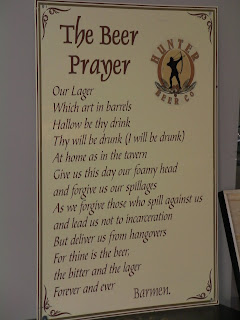










The Margaret River wasn't what I expected. I'm not sure what I expected really, but what we found wasn't it. It turned out to be quite different, and quite exciting. We spent as much time climbing to the top of the lighthouse, and going into underground caves as we did visiting wineries and tasting wine. There are over 90 wineries in the area - everything from the big internationally known ones to small boutique wineries, and we visited a random selection of them. In addition, there are olive oil producers, great restaurants, lots of local art galleries and museums. We could have done more, had we more time to spend in the area.
The wineries share land with the karri forests. Driving down the main roads, if you didn't know there were wineries behind the trees, you'd miss quite a few of them. There are vineyards along the roads, but most of them are further back. Beaches, forests, caves and eco tourism are an important part of the Margaret River area. The town itself is nine miles inland from the Indian Ocean and is part of the Leeuwin (pronounced LOO WIN) Naturaliste Ridge.
Walter and I visited the lighthouse at Cape Leeuwin - the most south-westerly point in Australia. It's where the Indian and Southern Oceans meet. We could actually climb to the top of the lighthouse and look out over two oceans. Awesome! The lighthouse was opened in 1896, is the tallest on mainland Australia, and is still in operation today. Things were certainly built to last in the 1890s. The walls at the base of the lighthouse are two metres thick, tapering to one metre at the top. Our guide told us that there are about 30 days per year where the wind can exceed 100 km per hour - hurricane force. The staircase (which was made in England) to the top is the original metal narrow one, and spirals its way to a narrow door (even I had to duck to avoid hitting the lintel) before stepping outside just underneath the light. The spare parts for the stairs, also from England, are still in the storage room at the bottom of the staircase ready to be used if ever needed.
One of our fellow tourists asked the guide why lighthouses are still in use, in this era of GPS. Our guide, Paul, replied that each lighthouse has its own frequency. By determining the frequency, and referring to the appropriate chart, anyone can determine where they are. Ships' power can fail from time to time, and when that happens navigational equipment is useless. And lastly. GPS' can sometime be misleading. I can attest to that, as ours (we call her Martha) sent us along a dirt toad to the back gate of Xanadu winery! At least we saw kangaroos on that detour. All was not lost, as a reference to the local tourist map showed us how to get to the front entrance on a paved road. Just goes to show that old technology isn't always obsolete technology.
We visited three of the caves in the area - Jewel, Mammoth, and Lake Caves. Jewel Cave was discovered in the 1960s, and is the largest limestone cave in the area. Lake Cave is the deepest and is right under the main road. Over 300 steps down, and 300 steps back up. Talk about a work out! It was originally discovered in the 1800's (I don't remember when) by a young girl out riding on her horse. The horse stopped and wouldn't go any farther. When the girl dismounted to find out why, she discovered the cave. She went back to tell her family. Unfortunately, the area was difficult to find again, and it became somewhat of a family joke - the cave that doesn't exist - until about thirty years later when one of her family members stumbled across the cave entrance! The guide told us that the first two formations were only 2 1/2 metres inside the cave. They are called Headache and Splitting Headache. In other words - duck. The ceiling is so low that anyone entering needs to duck or crouch down (and this while we're still going down stairs). A bit of a contortion, as we had to keep that way while descending over a dozen steps, but definitely worth it.
After four days, we returned to Perth and flew back to Sydney on the following day. It's been a great trip, and as much as I like to travel, I'm now looking forward to going home.










































